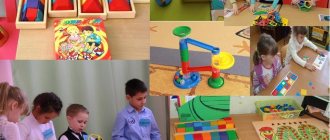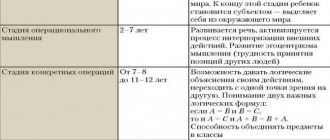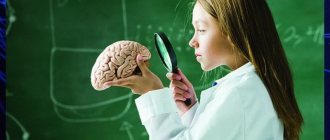Save article:
The article explains:
- Types of memory
- Exercises for developing different types of memory
- No less effective ways to develop memory
- Types and properties of attention
- Methods for developing attention depending on the desired characteristics
- Popular ways to develop attention
Developing memory and attention is something that needs to be done on a regular basis.
And the reason is not only that the life of a person with “pumped up” skills of this kind is much easier, more comfortable, more interesting and, in some cases, even safer. There are more serious reasons. So, if you do not devote time to such training, then sooner or later your memory will begin to fail, and concentration will require some incredible effort. It’s like with muscles: if you give up physical exercise for a long time, they will lose their strength.
Types of memory
Memory is the mental process of preserving and reproducing past experiences, allowing one to accumulate information without losing previous knowledge and skills. It allows a person to expand his cognitive abilities. In order for there to be more such knowledge, this psychological process needs to be developed. First, you should determine what type of memory you have best “pumped up”. There are 4 types of this cognitive ability:
- Auditory
- allows a person to understand the meaning of information and quickly process it. - Visual
– thanks to it you can receive and save visual images and subsequently reproduce them in your mind. - Motor
– with its help a person can record and reproduce movements, developing skills. - Complex
– memory that combines the above skills.
Types of memory
Depending on the duration of consolidation and storage of received information, memory is divided into short-term, long-term and operational.
Long-term memory is the ability to recall information throughout life, such as where we were born, what school we graduated from, and so on. The memory constantly refers to past experience, supplements it with new information, and corrects the acquired information. To put it simply, a person does not need to memorize what he knows well.
We need short-term memory in order not to fill the brain with unnecessary information. For example, the confirmation code sent via SMS to register on the site will never be useful to you again, and you are unlikely to remember it in a few hours.
Working memory refers to memorization that is needed for certain situations. A person can hold in his head the information he needs to do real work. When data becomes irrelevant, the brain erases it, making room for new events.
Children's attentiveness
Spontaneous responses arise and persist regardless of our goals. Due to their fascination or surprise, stimuli capture and distract the individual from his activity.
Face-to-face consultation
What are the features and advantages of face-to-face consultation?
Find out more
Skype consultation
What are the features and benefits of Skype consultations?
Find out more
Babies are unable to concentrate on one specific object. They are fascinated by a variety of things - a cell phone, mom's cosmetics, dad's tools. At this age, babies are very curious. When a child grows up, he receives a lot of information and learns that on our planet there are a large number of animals of various species, insects, and plants. They begin to understand people better, distinguish hair color, eye color, skin color.
At the very beginning of life, parents help babies comprehend the world; they instill their own attitudes in the child, explain the line between good and evil, and teach them to talk. Then the baby himself begins to explore everything around him, reacting to what seems bright, unusual and unknown to him.
Children cannot regulate their own attentiveness, since they have passive concentration. Therefore, kids are attracted to various strange objects that come into their field of vision. A child may carefully look at a toy that was given to him, enjoy it, but after a minute switch to another thing. Therefore, it is easy to calm a baby down when falling or crying - you just need to distract him from the painful sensation or an unwanted object.
The ability to concentrate on one object appears in a child in the sixth year of life. I recommend praising him for any manifestation of perseverance and willpower before this age - since this is not easy for a baby. Praise will let him know that his efforts are appreciated, so he will begin to try harder to please his parents with his small victories.
If all attempts at attentive concentration are in vain, do not scold your child, ask him to try again. By reacting negatively, you will discourage your child from all the desire for knowledge, learning and perseverance.
Exercises for developing different types of memory
- For visual
You can play a game to develop memory and attention called “find the differences.” For this purpose, there are already ready-made pictures on this topic on the Internet. You can install a mobile application in which the developers have included all possible exercises for training thinking.
Free online intensive
Your Path to IT starts here
More details
- For auditory
There is an exercise called “10 words”. Write on paper a number of words that have absolutely no semantic chain, and try to repeat them from memory. If you succeed, then their number can be increased.
Another exercise for developing memory and attention can be used on the way home or to work. While listening to music, stop the song anywhere and try to reproduce its continuation in your head. A good result will be the ability to mentally scroll and stop your favorite song.
- For motor
To develop motor skills, there are exercises that involve both hemispheres of the brain. For example, “circular exercises and tapping.” The key here is to use two hands. With one palm of your hand you need to make circular movements on the surface of the table, and with the other, clenched into a fist, you need to knock evenly on the tabletop.
No less effective ways to develop memory
- “Pump up” the memorization process
The associative method is fundamental in the development of memory. It is imperative to master it, because it is functional in itself and is an integral part of most methods of effective memorization. You are supposed to relate new information to what you already know. This method is often used when studying foreign languages, where the sound of words is compared with similar ones in the native language.
This method can be applied to any type of information. If they're numeric values, consider maybe they're similar to someone's date of birth or home phone number or age. But remember, the more banal your associations are, the less likely they are to help effectively. On the contrary, the more unusual the connection between elements, and sometimes the funnier, the better it is remembered.
Materials from the paid collection of GeekBrains on achieving an income of 150,000 ₽ remotely
Do you want to earn more or work remotely? Confused by the variety of professions and don’t know where to go?
The GeekBrains team, together with career experts, have prepared documents that will help you find and choose an in-demand, highly paid profession.
Alexander Sagun
Chief career consultant
Download and use today:
Job search channels
List of 26 resources and 34 Telegram channels
Top 30 most in-demand and highest-paid professions 2022
Rating of the most relevant specialties in 9 areas
Typically, documents are only available to Career Workshop students, but we decided to share them with you for free!
Download and take the first steps towards your dream job or business!
- Reproduce small details
This method will help you find your lost item. Everyone has had situations when they forgot their keys, phone, headphones, etc., but they couldn’t remember where you left them. In this case, you need to concentrate and think logically about where this thing might be.
If it is not in the checked places, then it is worth recalling in your memory the latest events related to this item, remembering the last time you held the lost item and what happened then. By remembering as many details as possible that accompanied the item you were looking for, you will be able to find it.
- Speak out what you need to remember
Say important information out loud to yourself, for example, “tomorrow at 2:35 pm there is a dentist appointment.” This way you can remember the information much better than if you wrote it down in your diary.
- Constantly count
Simple calculation problems train the brain very well and develop logic. Thanks to this method, you can disconnect from problems and routine. Currently, there are many sites on the Internet with mathematical puzzles and rebuses that force you to look for solutions and patterns.
Types and properties of attention
Attention is the focus of human consciousness on specific objects and phenomena that have special significance for a person. It can be of several types: involuntary, voluntary and post-voluntary.
- Involuntary attention (emotional or passive)
is the concentration of consciousness on a specific object in connection with its characteristics. Any stimulus can attract interest. In this case, a person’s moral and intellectual feelings play a big role. Depending on this, the duration of attention is determined. - Voluntary attention (volitional or active)
is conscious concentration on an object. In this case, a person focuses on what he needs to do. This occurs when a person has a goal to do some work that requires concentration. - Post-voluntary attention
is concentration aimed at completing a given task without much effort, that is, it is based on previously acquired knowledge. In this case, internal motivation (attraction that arises from within a person) prevails over external motivation.
Now a little about the features of the development of attention and memory.
Motivation plays a big role in maintaining attention on an object. Scientists have proven that a person can continuously concentrate for no more than 40 minutes, and after that he needs a break. The features of attention are expressed in its properties, a little about each of them.
The volume of attention is expressed in the number of simultaneously perceived objects. This depends on several factors: genetics, professional skills and short-term memory potential.
Concentration is the ability of the psyche to continuously focus on an object. Thanks to this property, you can discover something new in ordinary things.
Distribution - a person is able to simultaneously perform several actions or observe several objects. In this case, the brain can optimally distribute the excitability of cortical areas, which makes it possible to control several processes. The disadvantages of this property include rapid fatigue.
Switchability is a restructuring of a person’s attention from one object to another, and it can be either voluntary or not. Depending on the individual’s interest in the type of activity, volitional efforts will be manifested.
Features of voluntary attention
A feature of voluntary attention is the activity of the individual in achieving goals, without taking into account preferences at the moment. This ability is formed gradually, which is characterized by a period of unpleasant sensations associated with internal tension of willpower, but as this skill is acquired, the tension goes away, and the discomfort from the need to maintain concentration by all means decreases significantly.
This quality can manifest itself not only independently, but also influence other processes. Thanks to active use and the ability to determine the direction of his attention, a person also regulates his memory, choosing the necessary moments, adjusts the pace of various processes, adjusting them adequately to the situation, and also completely regulates activity for the sake of the final result.
From the physiological side, this process is due to the involvement of the frontal lobes of the cerebral cortex, which are responsible for correction, as well as programming the future activity of the individual. The peculiarity of the activation of these areas is that the stimulus (signal that can change activity) comes from the second signaling system. This means that thought becomes a priority signal in comparison with the environment, which means that stimuli emanating orders from the inner “I” have an advantage in guiding activity and the direction of attention. This excludes complete control of the brain over human behavior, because Self-preservation instincts still occupy the most influential place among all internal processes of action regulation.
The features of this higher mental function are due to mediation and awareness, which implies a certain development of the psyche by the time voluntary attention is established. It is based on minimal volitional efforts, the ability to perceive and self-awareness with further linking of existing factors and desired results. Voluntariness arose in the course of evolution as the ability to transform reality through its activity, therefore, like all acquired functions, it necessarily goes through accelerated stages of evolutionary appearance in each phenomenological history of the individual. Typically, the period of formation of the ability to consciously direct attention is formed from birth to six years, and then it is increasingly honed thanks to the education system and the efforts of the person himself. This is another key feature - the education system, the features of the child’s involvement in the process and the influence of others. The speed of skill formation and its level of development depend on these factors.
Methods for developing attention depending on the desired characteristics
Most methods for developing attention are aimed at accelerating the onset of post-voluntary attention, as well as the ability to quickly concentrate. Various games and techniques will be a good helper in memory development.
Each person has his own level of concentration, but despite this, everyone needs to conduct developmental activities. Thanks to them you can get rid of absent-mindedness.
Spend your free time solving puzzles, solving logic problems, or playing chess. The process of developing attention and memory should be a joy and pleasure for you. Only under this condition can the brain function well.
Any activity should be accompanied by silence, because this is how you can achieve complete concentration on a new object or subject of study. The development of visual attention sometimes includes simple exercises. Having mastered them, a person gains a new skill in focusing on life goals and tasks. It is important to alternate tasks, mix difficult tasks with easy ones, interesting ones with uninteresting ones.
How to develop attention
We remember that the purpose of attention is to pick out figures from the background: this is what is called concentration
.
But there is also a reverse process, deconcentration, alertness
, when there is no figure, but only a background, completely filled with attention. When we perceive the world holistically, we find ourselves in a state akin to flow, accumulating all experience at the edge of the moment and ready to take our ideal action. How can you boost your attention?
Cognitive simulators, or special programs and games
Pros: they give good results at the beginning, when the brain is still faced with a new task - it stimulates sleeping areas and promotes progress.
Cons: Once the brain adapts, addiction sets in. Progress in mastering the simulators continues, but the skill does not transfer to life. When working with simulators, you are working with an external stimulus, but it will not put your brain in an active position: there is simply no object outside that would draw your attention to itself.
However, simulators work effectively in conjunction with formal (occurring in isolated situations) and informal (occurring in real situations) practices.
Formal practices - Eastern approaches (yoga, Dzogchen)
Pros: meditation is still the most effective tool for working with attention.
Disadvantages: Conscious yoga and qigong practice impose certain ideological restrictions, which may be unacceptable for some people.
Source: francescoch / istockphoto.com
Informal practices
Pros: various game and metaphorical trainings and exercises to engage in the moment, as well as playing out real situations with the activation of dormant cognitive functions give a good shake-up to the brain and activate attention.
Cons: without systematic work, the result quickly fades away.
Thus, disparate practices, ideology and esotericism, as well as cultural restrictions can generally slow down mass attention work. To scale it up, a special engineering technique is required, which would have a scientific basis and has proven its effectiveness on large projects.
Volitional techniques
Pros: Unlike eastern practices, psychonetics is aimed at results and creativity and is therefore suitable for the active life of a purposeful person.
Disadvantages: you need to independently find an approach that will work for you; regularity also plays a key role.
The word “will” is directly related to attention; we can safely say that one follows from the other. It is by taking a strong-willed position that you begin to control your attention and live in the “I want” paradigm. An example is the case of Natalia Molchanova, a record holder in freediving, who, with the help of volitional practices, solved the problem of blackout - loss of consciousness and orientation in space during deep dives. A volitional position implies observation of the mechanisms of consciousness and allows you to correct its work even in such extreme situations.









